
In our clinic, which is dedicated exclusively to canine nutrition, digestive problems in dogs are our daily bread; from inflammatory bowel disease (IBD), to lymphoplasmacytic enteritis, Crohn’s disease, inflammatory colitis, and histiocytic ulcerative colitis.
What do all of these pathologies have in common? In general, there is an inflammation in the intestine which results in a series of problems, generally leading to the intestine becoming permeable, thus allowing substances to pass through it that should not do so. To put it simply, this is the crux of the matter.
Do you know what continues to amaze me? That thousands of different treatments are administered to these patients, such as anti-inflammatories, antibiotics, ultrasound scans, etc., and although a considerable amount of money is invested in these patients, they are still being fed dry, highly industrialized, non-perishable pellets. Does it seem logical to you that a person with such a serious intestinal disease should be fed in such an unnatural way? No, of course not!
Very often dogs arrive at the clinics with itchy skin, biting their paws or scratching at their ears: obvious signs of the existence of an allergy, or more likely, food intolerance. Even if they are treated, most of the time the symptoms do not disappear, or if they do, they reappear soon after.
What causes this to happen? A major reason is due to not providing specific natural diets that will not further irritate the intestinal lining and help balance and maintain microflora (the microbiome), thus soothing and strengthening the intestine, as well as providing orthomolecular nutrients that fight inflammation and strengthen the most essential cells of the intestine, namely the enterocytes and colonocytes of the small and large intestine, respectively.
An increasing number of studies are showing the importance of the microbiome in improving or worsening the condition of these patients. Without quality nutrition and orthomolecular nutrients (not canned food or dry kibble), in addition to key medications, this is virtually impossible.
How a dog’s digestive system works
I will briefly explain the process of digestion in dogs, which is basically the same, to a greater or lesser extent, for all carnivores.
The mouth
When a human eats food, they chew it a lot and produce saliva which contains amylase, the enzyme needed to break down carbohydrates. Dogs, cats and carnivores in general, tend to chew very little, and their saliva does NOT contain amylase.
Why? Because they eat low amounts of carbohydrates, 10 to 15% of their total diet, whereas animal feed contains around 50% to 75% carbohydrates in the form of corn, rice and wheat, etc., which is totally unnatural for them.
The stomach
Then, it passes through the esophagus, which is basically the tube that connects the mouth with the stomach. And it is in the stomach where this type of animal primarily digests food, in contrast to humans and herbivores, which do it mainly in the intestines, except for ruminants, such as cattle and sheep, which use their four stomachs.
Carnivores secrete very acidic gastric juice, with an average pH of 1 or 2, while humans have a pH of around 4 or 5. Why so acidic? As they are carnivores, the way they break down meat and maximize its benefit is through these acids, which break down proteins into their simplest units: amino acids.
The small intestine
Once the meat and fat (the main food of carnivores) have been broken down in the stomach, they pass into the small intestine, where most of the absorption of nutrients—the proteins, fats and carbohydrates—takes place.
It should be noted that the intestine has different parts: duodenum (in direct contact with the stomach -pylorus-), jejunum and ileum, where, roughly speaking, the different types of nutrients are absorbed. Pay special attention to this part, the small intestine, because it is the subject of this article: leaky gut.
Large intestine
The large intestine, also known as the colon, is made up of various parts: the cecum, the rectum, and the anus. The colon is divided into ascending, transverse, and descending. Here the food that has been ingested arrives in almost liquid form, which is known as “chyme”, and something very important happens here: the absorption of water and electrolytes (sodium and potassium, etc.) from the chyme. What happens to that chyme when the liquid is absorbed? Well, it is compacted and feces are formed, more or less compacted, which will later be excreted.
Throughout this journey, there are some microorganisms found in the small and large intestine, which are of particular relevance to this article. The gut microbiota, microbiome, or microflora, are microorganisms which number in the billions. We’ll talk more about them later, because their quality, in general terms, good or bad, are important factors which can lead to the formation of a leaky gut.
If the balance of positive bacteria is not favorable, the gastrointestinal system becomes unstable, which in turn disrupts the digestive process. As a consequence, the mucus layer of the intestine becomes inflamed and permeable, and large amounts of partially digested substances from food particles can leak into the bloodstream.
What happens then? Well, these large and complex substances are unhygienic and allergenic, and stimulate the immune system to produce antibodies against them. This can lead to leaky gut syndrome.
The microbiome in dogs: the foundation of good health
I’m sure you’re wondering: what is the microbiome?
They are the microbial communities of bacteria, viruses, fungi, archaea, protists and many other microorganisms, that are found, among other systems, in the gastrointestinal tract.
An example I often give to emphasize the importance of the microbiome: “If I could somehow magically remove all the microbiome from your or your dog’s body, in a few minutes you would drop dead.” This is how important their role is in our lives.
Another example: 90% of the cells in our body are microbes (the vast majority of which are in the intestine), in other words, we are more microbe than human! And the same is true of your dog or cat, they are more microbe than dog or cat, it’s as simple as that.
You may be wondering how important these little “bugs are”. I can assure you that they are a vital part of the body and these microorganisms outnumber your dog’s cells by 10 to 1.
“The number of microorganisms inhabiting the GI tract has been estimated to exceed 1014, which encompasses about 10 times more bacterial cells than the number of human cells [and over 100 times the amount of genomic content (microbiome) as the human genome]. The intestine is estimated to harbor many thousands of bacterial strains.” (Canine and Feline Gastroenterology by Robert Washabau and Michael Day)
You may have heard that 70% of the immune system resides in the gut. That’s because the microbiome there plays a key role in the function of the immune system. It’s like a “virtual” organ that plays a fundamental role in the health and immunity of your dog.
So, if their microbiome isn’t healthy, your pup cannot be healthy. This is why many medications, highly processed diets (such as kibble) and allergy treatments don’t work in the long-term, as they all disrupt the delicate balance of the microbiome, making them more prone to allergies and other autoimmune diseases.
Important functions of the gut microbiome
The bacteria present in the microbiome have some very important functions for the organism:
1. They produce fatty acids and vitamins
Intestinal bacteria, in addition to aiding digestion, also synthesize very important compounds for the proper functioning of your dog’s body, such as vitamin K and group B vitamins: B12, biotin, folic acid and pantothenic acid.
Bacteria in the small intestine contribute in varying degrees to gastrointestinal health, while those in the large intestine are generally beneficial to their host. Clostridiaceae, Dorea spp., Lachnospiraceae, Ruminococcus spp., Faecalibacterium spp., and Roseburia spp are the predominant bacteria found in the colon.
The bacteria present in the colon provide digestive enzymes that help the utilization of complex carbohydrates. For example, 8% of the Bifidobacterium longum genome is made up of genes required for metabolizing carbohydrates.
They also produce short-chain fatty acids (SCFA), which are very useful as a source of energy for the cells of the body. We are mainly talking about complex carbohydrates which include starch and dietary fibers such as inulin and pectin.
The fermentation of these substrates is what gives rise to these SCFA such as acetate, propionate, and butyric acid, which are extremely beneficial and healthy for the colon, for example, and in many of our patients with colitis we prescribe butter. Can you guess why? Because it is rich in butyric acid which is found in small amounts in some fats such as butter.
The amount of energy produced by these SCFA is not negligible, up to 7% of the energy of a dog and a little less in cats, and all thanks to this colonic fermentation.
2. They help digestion and the absorption of nutrients
As we have seen, the intestine is the area of the body most colonized by bacteria, because for them it is an ideal place to develop, since they are protected from external alterations and, in addition, it is the place in the body with the most nutrients available for their growth.
But it is not only the bacteria that benefit from this relationship; they also help the digestion of food to occur properly. These bacteria promote intestinal movement, so that food circulates more efficiently, thus enhancing the absorption of nutrients and avoiding gastrointestinal problems.
In addition, the intestinal flora helps the intestines to absorb calcium and iron. These two minerals are essential for the proper functioning of many vital processes, but they are difficult to assimilate in the intestines without the presence of these bacteria.
They also help break down complex foods into simpler nutrients that can be assimilated by cells, and allow the digestion of compounds that cannot be broken down by themselves.
As a result, if your dog suffers from alterations in the composition of the intestinal microbiome, it can cause constipation, diarrhea, abdominal pain, and gas, etc.
That is why the intake of antibiotics often leads to intestinal problems, since they not only kill pathogens, but can also reduce the population of beneficial bacteria.
3. They activate the immune system
Your dog’s immune system is perfectly designed to recognize and attack anything that does not have the same genetic makeup as your dog’s cells. Therefore, it would have to try to neutralize all of these bacteria that make up the microbiome, since, in theory, they are foreign to the organism.
However, if it did that, it would be harmful to your health, so it has evolved to ignore these bacteria and allow them to grow and reproduce.
Although it does not attack them, the immune system is always constantly on the lookout for any of these populations that may grow excessively, as this can lead to health problems. There must be a balance in the bacterial populations, and none should be allowed grow more than necessary.
Constant vigilance ensures that the immune system never relaxes, so that if a pathogen enters the body, the immune system cells will already be ready to fight the infection.
Experiments using germ-free animals—mainly mice born and bred in the laboratory, free of certain germs in the intestine for experimental purposes—have shown that the absence of germs alters the architecture of the intestinal mucosa and reduces the replacement of epithelial (surface) cells in comparison with normal animals.
The underdeveloped immune system of these germ-free animals is rapidly restored when bacteria are introduced. In our clinic, a fundamental part of improving nutrition, especially in digestive patients, is the provision of probiotics. We will talk about them below.
Other key parts in this defense system are epithelial cells, protective mucus, and gut-associated lymphoid tissue, or GALT.
The increase in the diversity of colonizing microbiota at weaning strengthens the resistance against colonization by pathogens. That is why it is important that the puppies stay with their mother for two months, and from day 18, they must be provided with NATURAL food, rich in enzymes and good bacteria, while the mother provides only MILK SUPPLEMENT, in addition to the other functions of protection and play, and so on.
Moreover, the resident microbiota promotes the maturation of the immune system. Puppies with underdeveloped microbiota diversity and immature GALT rely on colostral antibodies as well as milk components.
Furthermore, the resident microbiota tries to achieve the maturation of the immune system. Puppies with underdeveloped microbiota diversity and immature GALT rely on antibodies from colostrum as well as dairy components.
Young animals are typically more susceptible to invasive pathogens such as Campylobacter, giardiasis, etc. Studies in rodents suggest that the pattern of microbial colonization in early life may influence their physiology and resistance to colonization in adulthood.
In our clinic we see many puppies with intermittent and chronic diarrhea associated with giardiasis. They tend to come from mothers who, during the first years of their lives, have been fed exclusively with commercial feed such as kibble, and, as a result, are often malnourished. So, it is to be expected that they have a weak digestive immune system, which gives rise to colonization by such insidious microorganisms as giardiasis and others.
In addition to switching to natural foods and quality nutrition cooked by the owner, the intestine is strengthened through orthomolecular nutrients such as probiotics and amino acids, targeted specifically to the intestinal cells.
4. Bacteria in the microbiome protect against pathogens
Invasion of specific pathogens such as Salmonella, Giardia, C. perfringens, and Campylobacter jejuni, among others, greatly affect the mucosal structure of the intestine.
These pathogens can penetrate the mucosa and Peyer’s patches, or produce enterotoxins that alter the function of the enterocytes, the primary cell of the small intestine. Enterotoxins stimulate the secretion of mucosal fluids, and when the villi are swept away, there is loss of surface area leading to the absorption capacity of the mucosa to be diminished.
The result is that the mucosal-generated fluid is not absorbed resulting in diarrhea. This dysfunction of the mucosal barrier can lead to increased permeability as well as bacterial translocation with significant clinical consequences.
Click here and fill out the questionnaire so that we can start working together.
Best regards


